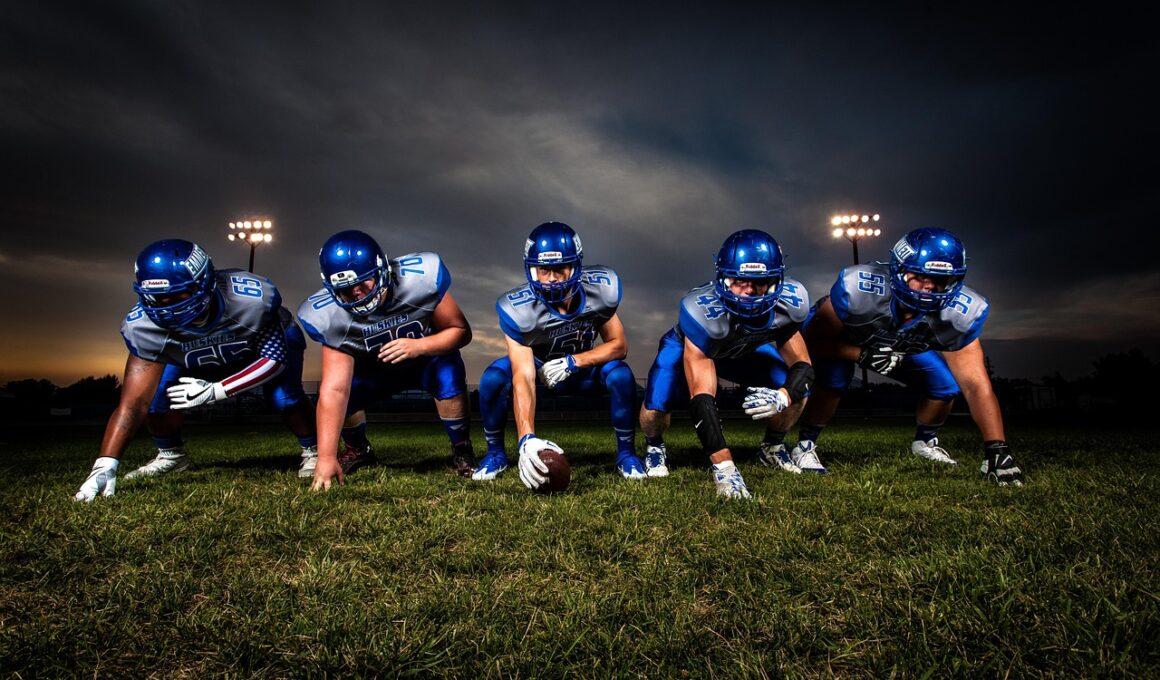Stability Drills to Prevent Football Injuries
Football is a physically demanding sport that requires players to be agile, strong, and stable. Part of maintaining athletic performance lies in improving balance and stability. Incorporating stability drills into regular training routines can effectively help prevent injuries. These drills strengthen the muscles surrounding joints, enhance proprioception, and improve coordination, all essential for maintaining control during dynamic movements on the pitch. Engaging in regular stability practice allows athletes to develop a solid foundation, making them less susceptible to awkward movements that lead to injuries. Players should invest time in exercises focused on balance, such as single-leg stands or stability ball workouts. Furthermore, consistent practice enhances core strength, which plays a pivotal role in overall athletic performance. This forms the crux of effective injury prevention strategies that every footballer should adopt. Beyond just physical benefits, these practices can enhance players’ confidence, allowing them to perform their skills with greater assurance. Coaches must emphasize the importance of balance training to their players, ensuring it becomes a fundamental aspect of football training. By prioritizing these exercises, athletes can maintain optimal performance while reducing the risk of injuries significantly.
One effective stability drill is the Single-Leg Balance. This exercise enhances proprioception by engaging stabilizer muscles, improving overall balance. To perform this drill, find a flat surface and stand on one leg while lifting the other leg slightly off the ground. Maintain this position for up to 30 seconds. To increase difficulty, close your eyes or engage in arm movements. This simple yet efficient drill can be performed daily and can significantly impact your balance over time. Incorporating variations such as reaching for an object while on one leg also challenges balance. Another powerful exercise is the Stability Ball Balance. Sit on a stability ball with your feet flat on the ground and slowly lift one foot, holding it for 10 to 20 seconds while focusing on maintaining balance. This drill targets core stability and improves overall strength. By regularly practicing these drills, players will notice improvements in their ability to perform on the football pitch. Coaches should encourage players to integrate stability drills into their warm-up routines for best results. Enhanced balance contributes to better performance and a lower risk of injuries during games.
Incorporating Stability Training into Warm-ups
The incorporation of stability training into warm-up routines is paramount. Proper warm-ups not only prepare muscles for intense activity but also establish a foundation for injury prevention. A comprehensive warm-up should consist of various exercises aimed at improving flexibility, mobility, and stability. Players can start with dynamic stretching, followed by specific stability drills that activate the core and improve balance. A typical warm-up routine might include exercises like lateral lunges and single-leg squats. Lateral lunges help improve hip mobility, while single-leg squats engage the core and leg muscles. By consistently implementing these exercises, players become familiar with balance training before heading onto the pitch. The warm-up is the ideal opportunity to reinforce stability training principles. Coaches can facilitate group exercises, creating a team environment that fosters improvement and camaraderie. Participants should be encouraged to share their experiences and techniques, making the learning process collaborative. As players gradually improve their balance, they’ll notice improved reaction times and coordination during matches. Ultimately, a well-structured warm-up sets the tone for the training session, blending performance and safety.
Balance Board Training is another effective stability drill to help prevent injuries. A balance board adds an unstable surface challenge, engaging core muscles, enhancing overall stability. To utilize a balance board, stand centered on it with feet parallel and balanced. Gradually shift your weight from side to side and front to back without falling off. Begin with short intervals, progressively increasing the time spent balancing as skills improve. Players can also incorporate dynamic movements such as squats or lunges on the board. This variation compounds the benefits, targeting various muscle groups while honing balance. As you increase difficulty further, consider using a weighted vest or performing exercises on one leg. Balance board training not only improves athletic skills but also reinforces mental focus and body awareness. Regular use can dramatically decrease injury risks by developing the muscles crucial for stability. Recommended frequency for balance board sessions is 2-3 times a week. Coaches can provide guidance on correct posture and technique to maximize benefits. When players realize the significance of stability training, they’ll embrace it wholeheartedly for better performance.
The Role of Strength Training
Strength training complements balance and stability drills, making it a necessary part of a comprehensive injury prevention program. Enhanced strength means stronger muscles, tendons, and ligaments, reducing the likelihood of injuries during football activities. Focus on functional strength exercises that promote balance, such as deadlifts and lunges. These exercises engage the entire body, enhancing core strength while targeting specific muscles necessary for football. Furthermore, incorporating Olympic lifts, like clean and jerk, can develop explosive strength and stability, beneficial for performance. Adequate strength also plays a vital role in decelerating movements, which are crucial during sudden stops and changes in direction that occur frequently in matches. Cross-training options such as swimming or cycling can support overall strength and stamina without imposing additional stress on joints. Integrating light resistance bands into stability drills can build strength while improving balance. Lastly, adequate rest and recovery are integral to prevent overtraining and fatigue, which can increase injury risk. Encourage players to prioritize strength training consistently to reap long-term stability benefits on the pitch.
Proprioceptive Training is key to stability development. Proprioception refers to the body’s ability to sense its position and movement in space, crucial for performances in football. Exercises targeting proprioception enhance awareness of body positioning, aiding in balance and coordination. A simple yet effective proprioceptive exercise is the Eccentric Squat, where players lower themselves slowly to the ground. This action helps players become more aware of their bodies in motion. Another drill involves using unstable surfaces, like wobble boards or BOSU balls, which challenge the body’s ability to maintain balance, thus enhancing proprioceptive skills. Performing activities such as balancing on one foot while executing a pass further solidifies these principles. Coaches can incorporate these activities into routine training sessions effectively, ensuring players are engaging with proprioception in their drills. Consistent proprioceptive training can contribute to improved agility and quick foot movement, necessary for effective performance on the field. Encourage players to practice these exercises regularly to optimize their balance and reduce the risk of injury significantly.
Goal Setting and Progress Tracking
Establishing specific goals for balance and stability drills is fundamental for improvement. Setting SMART goals, which are Specific, Measurable, Achievable, Relevant, and Time-bound, allows players to track their progress effectively. For example, a player might set a goal to maintain single-leg balance for one minute continuously within a month. Tracking performance in terms of duration and complexity can motivate athletes to stay committed to their training regimen. Coaches can help establish group goals, fostering team spirit and collective accountability. Periodically assessing progress with predefined benchmarks encourages players to focus and work towards their objectives. Incorporating visual aids like charts can enhance motivation by visualizing their journey. Engaging in competitions where players challenge each other can also create a fun atmosphere for stability training. Additionally, reviewing sessions’ outcomes allows for tweaks in drills or exercises targeting areas needing improvement. By cultivating a goal-oriented mindset focused on balance and stability, players may perceive clear pathways to enhance their abilities. This focus can be crucial, particularly before competitive seasons, as stability training directly correlates with performance readiness.
In conclusion, stability drills play an essential role in preventing injuries for football players. Balance and stability training not only improves players’ performance but also fosters their physical health and longevity in the sport. Incorporating a variety of stability drills, such as single-leg balances and balance board activities, enhances core strength, proprioception, and overall athleticism. Coaches and players should prioritize including stability training in their daily routines, particularly during warm-ups. The integration of strength training and proprioceptive work further strengthens the commitment to injury prevention. Setting specific goals and tracking progress can foster a culture of improvement and resilience. Preparing adequately from a stability perspective can significantly contribute to better on-field performance. Thus, all players keen on excelling in football should embrace these stability drills wholeheartedly. As they progress, they will likely notice improvements in both their confidence and in-game efficacy. Ultimately, achieving balance and stability is a continuous journey that requires dedication, focus, and the right mindset. By adopting these techniques, players can enhance their skills and enjoy a safer football career.


